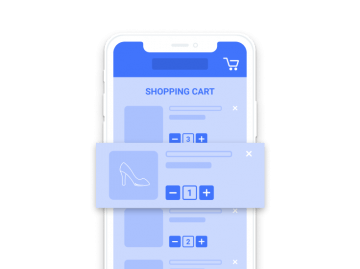We live in times of ever-changing technology, where new ideas emerge on a daily basis. Just when we thought that everything we need is already on the market, a new product or service suddenly appears. Every year we witness the evolution of existing products as well as a revolution sparked by innovation. 2019 is already promising to be extremely exciting in terms of changes to come (which we are all waiting for).
This article introduces a few trends in mobile design which, in my opinion, may be crucial in the new year. Read on!
Graphic design systems
Consistency in graphic design, the use of responsive components, and unified typography are the most important factors in how we perceive a digital product. Graphic design systems, which are collections of rules for designers, help to achieve that. Not so long ago, the main graphic systems were based on Material Design from Google and Human Interface Guidelines from Apple. However, the designer community went a step further and began to create their own systems. Currently, not only large-market players such as Uber and Airbnb, but also smaller start-ups, have created design systems for their products. In 2019, graphic design systems have the potential to become widespread and even more unique at the same time.
User Experience personalization
In 2019, companies will focus on building applications that match content to preferences. Thanks to machine learning and data analysis, the displayed content can be automatically matched to individual requirements. This will save the user time while searching for relevant content and boost the application’s ease-of-use. A great example of such solution is Spotify, which uses an algorithm to create playlists based on the analysis of musical preferences. Amazon, on the other hand, offers personalized suggestions based on previous purchases and search history. In addition, research also shows that 94% of online stores that use personalization have achieved a conversion increase. This means that personalization of the user experience has a significant impact on business efficiency and companies will be interested in using this (at least those in the know).
Content-first
Today’s fast-paced lifestyles and lack of time mean that most people want to speed up what they do: applications should do the same. They should be logical and intuitive, so that the user can reach an objective quickly. The key to this is to strip down the application leaving just the functions for which the product was created: without any unnecessary embellishments. This gives the user a fast and easy way to get right to their main objective in the app while also making it more satisfying to use. 2019 will be a year when we design through the prism of functionality and the essence of a product’s purpose.
Button-free interface
Can we imagine a user interface without buttons? For some time now, if you pressed a button, it implied a response within the application (an obvious and intuitive move). However, we have been getting used to the fact that we can do without the buttons, too. An evolutionary and controlled process has got the users used to such changes. Currently, many application users are ready to use the interface via gestures and automation of the program itself. An example of such a solution is the ING bank application which logs the user in automatically after entering the PIN. One interim step was removed which reduces the time required to access the account. Does anyone feel the need to use buttons on the main screen of Instagram? Instastories are launched by clicking on the photo of the person we are looking at. Photos are taken with a double tap. Swiping right turns the camera on, and swiping left brings up the messages display. Everything is really simple and intuitive.
Voice support
With a growing number of users getting into voice support features, more and more designers are using this technology. The Voice UI process has more to do with writing, building context, and synthesizing data than with the actual graphic design. In addition, a lot of attention is devoted to the issue of natural language processing, so that machines may have a better grasp of what is said to them. In the current year, the general public will learn to use a voice interface in everyday life. This is an important developmental direction that will also make devices and applications accessible to people with disabilities. In turn, the emergence of an increasing number of voice applications on the market provides valuable feedback from the users which will bring voice interface solutions to a much higher level.
Virtual Reality and Augmented Reality
What was only possible in sci-fi movies now is possible. Perhaps those responsible for the screenplays of such films did not expect that what they had written would be workable in the near future (e.g. Google glass and PS VR). Virtual reality is an area under constant development and improvement. The speed at which this technology is evolving may lead us to believe that in 2019, VR will be even better suited to user requirements and, therefore, an even more desirable feature.
Augmented reality is also gaining an increasingly strong presence. This year should be a period of major development in this field. Users increasingly opt to furnish their homes by testing various items in augmented reality before making an actual purchase. AR is already used in the automotive industry by displaying information from the on-board computer on the windshield. In addition, there are many areas that have led to further innovations in augmented reality such as medicine, aviation, architecture, and art (holograms!). And this is just for starters!
Biometric authentication
Currently, a great deal of attention is focused on the security of personal data. Our smartphones have banking services and other applications which require us to provide sensitive information such as personal data and credit card numbers (e.g. in Click2Go). This information must be as secure as possible so that unauthorized people have no access. 2019 will probably see a lot more solutions in the use of biometric authentication, which will increase security. Fingerprint recognition is already a standard, with face and facial expression recognition becoming more and more elaborate. MasterCard is planning to introduce its own Mastercard Identity Check technology this year, which, apart from face or fingerprint identification, will enable iris scan payment authentication.
Summary
The world is in a constant state of flux, so I think that the new year will bring many new technologies and solutions that we have no idea about right now. As designers, we should constantly update our knowledge to create products of the highest quality. When opting for technological solutions, however, let’s remember that they should be tailored to a selected target group. In the end, we design for the end users, not for the design process itself.
P.S. And yes, Mobile First is not a trend, it’s already a standard 😉
You might also like

Increasing mobile app retention focuses on the users returning…

Most marketing and e-commerce experts agree that m-commerce applications…

The number of people shopping through mobile devices is…

There has been much talk of e-commerce in recent…

App Store Optimization, or ASO, entails the process of…



